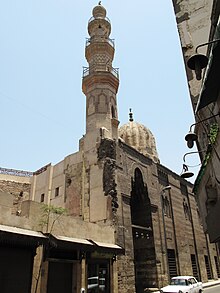Shaykhu

Shaykhu al-Umari an-Nasiri (died October 1357) was a high-ranking Mamluk emir during the reigns of sultans al-Muzaffar Hajji (1346–1347), an-Nasir Hasan (1347–1351, 1355–1361) and as-Salih Salih (1351–1355).
Biography
[edit]Shaykhu began his career as a mamluk (manumitted slave soldier) during the third reign of Sultan an-Nasir Muhammad (r. 1310–1341).[1] Shaykhu rose to become a high-ranking emir under Sultan al-Muzaffar Hajji (r. 1346–1347).[2] During the first term of the latter's child successor, an-Nasir Hasan, Shaykhu emerged as one of the four influential Mamluk emirs who wielded power in the sultanate.[2] An-Nasir Hasan moved to assert his authority over the emirs in 1350 by arresting Shaykhu and Emir Manjak al-Yusufi (com), imprisoning them both in Alexandria.[2] Shaykhu was pardoned in 1351 following Hasan's ouster and replacement by Sultan as-Salih Salih and the strongman of the sultanate, Emir Taz an-Nasiri (com).[2] Shaykhu returned to Cairo where he and Taz effectively held the levers of power and supervised the affairs of the state.[2] During this three-year period (1352–1355), Shaykhu commissioned the construction of a sabil kuttab (public fountain where the Qur'an was taught) in Cairo.[1]
Relations soured between Shaykhu and Taz, leading with the former gaining the upper hand and together with Emir Sirghitmish an-Nasiri, deposing as-Salih Salih and restoring Hasan to the sultanate.[2] Taz was soon after imprisoned on Hasan's orders, but Shaykhu compelled Hasan to assign him to Aleppo as governor instead, effectively exiling Taz.[2] Shaykhu was appointed atabak al-asakir (commander in chief of the military) by Hasan, giving him considerable power in the sultanate.[2] During this time, he was the first person to hold the title of emir kabir (great commander).[2] In 1355, Shaykhu had a mosque bearing his name built in Cairo, between Rumeila Square and the Ibn Tulun Mosque.[3] November 1357, Shaykhu was murdered in a council meeting of the Royal Mamluks (the top tier in the Mamluk military hierarchy).[4] Thereafter, his mamluk faction had their power restricted by Hasan.[4]
References
[edit]Bibliography
[edit]- Dobrowolski, Jaroslaw (2001). The Living Stones of Cairo. American University in Cairo Press. ISBN 9789774246326.
- Al-Harithy, Howyda N. (1996). "The Complex of Sultan Hasan in Cairo: Reading Between the Lines". In Gibb, H.A.R.; E. van Donzel; P.J. Bearman; J. van Lent (eds.). The Encyclopaedia of Islam. BRILL. ISBN 9789004106338.
- Mayer, L.A. (1933). Saracenic Heraldry: A Survey. Oxford: Oxford University Press. (pp. 11, 202− 205, his buildings 173, 202 f, 206)
- Muhammad, Abd al-Wahhab Bakr; Crecelius, Daniel (1991). Al-Damurdashi's Chronicle of Egypt, 1688-1755. Brill. ISBN 9789004094086.
